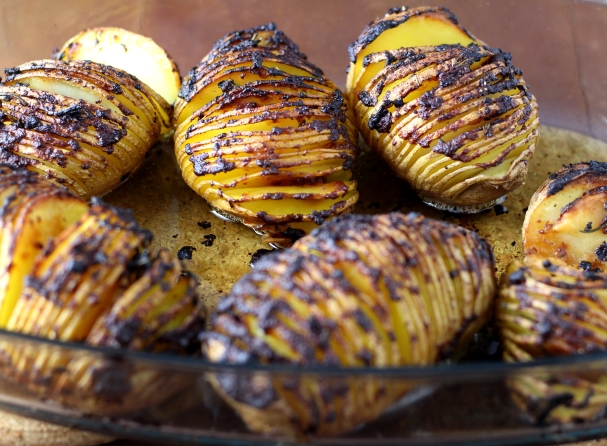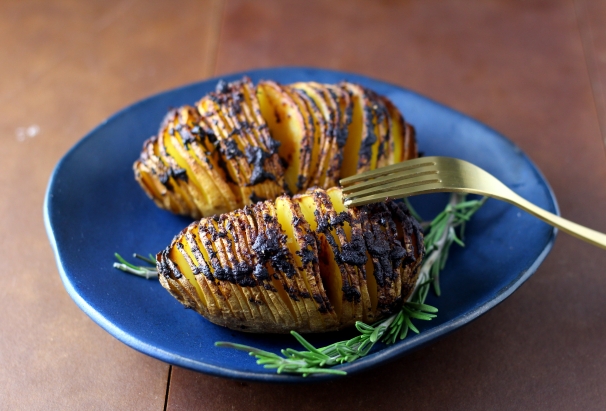Much like the fireworks on new year’s eve all disappeared unseen into a thick shroud of fog, the culinary start of 2017 also wasn’t quite what I’d expected. Creating new recipes is all about experimenting with things that sound good in theory. So, to start off 2017, here’s the story of how I tried to make the perfect hasselback potato.
The idea was to make hasselback potatoes with miso butter and rosemary. In my head it sounded amazing: the oven-baked potatoes, the deliciously umami miso butter – almost like Parmesan cheese – and the fragrant rosemary. The miso butter (4:2 butter to brown rice miso) was actually really delicious in real life as well, the potatoes themselves, well, they weren’t quite what I’d expected.

The problem, of course, was that I’d never made hasselback potatoes before. I’d seen them on photos and they always pleasantly reminded me of a certain type of wooden percussion instrument that goes by the charming name of güiro, but I never really understood the point of them. When I started to read around online, almost every website told me the same: hasselback potatoes are amazing and combine the best of both worlds, i.e. fluffy baked potatoes underneath, crispy slices on top.

My oven is never as hot as it pretends to be, but even after 1.5 hours (!) on the highest heat some potatoes could only be described as slightly undercooked. This also accounts for the miso layer, which went from a beautiful brown to an entirely different level of caramelisation. Oddly enough, the biggest potatoes with the most tightly packed slices most resembled the internet’s lyrical description of the hasselback. They were soft and fluffy on the inside, and the miso butter on top was tasty and moreish.The smaller specimens, with slices that fanned out more, had decided they would refuse to be either soft and fluffy or crispy and instead settled on tough and slightly crunchy.
From a scientific perspective, I guess the hybrid nature of the hasselback doesn’t do it any favours. Whereas a jacket potato is cooked by the steam that is contained within its own skin (and sometimes an extra jacket of aluminium foil), and roasted wedges or slices cook in a layer of fat, the slices on top of the hasselback sort of just dry out and become tough, in spite of the butter.

Trying to spruce it up by putting in a golden fork.
I might be wrong though, maybe it’s not them, maybe it’s me. Is it me? Has anyone here made hasselback potatoes before? And did they combine the best of both worlds? Any good tips? I would love to try again.
Oh, and before I forget, happy 2017 everyone! Here’s to a new year of fearless eating, green living and making your own!
That’s a shame, they still look pretty great though! Just from the pictures I was looking forward to trying it out. I say try again 🙂
LikeLiked by 1 person
Thanks, Lou! I will definitely try again! 😀
LikeLike
I does look perfect! 🙂
LikeLiked by 1 person
I’m no hasselback expert so I wouldn’t presume to say what went wrong, but when I made them I marinaded them in a spicy oil before cooking, then brushed them with the marinade again after the first half hour and they came out fine. I’m guessing maybe mine were more liberally coated so they didn’t go leathery before cooking through? I used medium-sized new potatoes and cooked them at 220C for about an hour. Your butter sounds absolutely delicious, btw.
LikeLiked by 1 person
Thanks so much for the tip, that sounds plausible! I did add more butter halfway through, but next time I’ll try marinating them a bit longer beforehand :). And if that doesn’t work, I think it’s fair to say my oven is to blame, right? Miso butter is great, although I think it would be more suited to drizzling over freshly cooked asparagus or other delicate veggies, which is definitely what I’ll use it for next time!
LikeLiked by 1 person
Every oven is different and some of them are just bloody-minded. 🙂 I love the sound of miso butter on asparagus, must try that when it’s back in season, thanks.
LikeLiked by 1 person
Hmm, I’m really craving it now. Can it be spring already? 😛
LikeLiked by 1 person
I wish.
LikeLike
PS Thanks for the follow, have reciprocated. 😀
LikeLiked by 1 person
You’re welcome! Really liked your blog’s focus on local and seasonal food, and I’m definitely a bit envious of your beautiful kitchen.
LikeLiked by 1 person
Thank you so much. Back atcha. 🙂 I look forward to swapping recipes in the future. Lx
LikeLiked by 1 person
Happy new year, Eli ! I’m sure your next attempt will be a success! 🙂 I found it cool, though, that you dared posting about a failure, that proves so much honesty and willingness to improve! Clap clap clap (applause)!
LikeLiked by 2 people
Happy new year to you too! And thank you for appreciating my honesty :P!
LikeLiked by 1 person
I’ve never made them, but see them anywhere! I’ve definitely curious now! Yours look delicious, of course. And miso butter – that’s a thing?!! I must have 🙂
LikeLiked by 2 people
Miso butter (just butter mixed with miso) is definitely a thing and I will definitely have more of that in the future (though not necessarily with hasselback potatoes 😉 )
LikeLiked by 1 person
You piqued my interest! 🍓
LikeLiked by 2 people
That’s good to hear! Let me know if you try them, I would love to hear how it works out for other people 🙂
LikeLiked by 1 person
You’re on! 🍓
LikeLiked by 1 person
Hasselback potatoes are the best!
LikeLiked by 2 people
I’ve always been curious about these but haven’t made them. Will be eager to see what others suggest. Cover them in foil for part of the bake perhaps? Ps Love your story and style! -Deb
LikeLiked by 3 people
Good tip, that’s what I was thinking as well! And then uncover them for the last bit to crisp up the top. It sounds good in theory… Thanks for stopping by, Deb!:D
LikeLiked by 1 person
They look pretty good to me! I’ve never tried hasselback potatoes but now I’m really curious.
LikeLiked by 3 people
Haha, thanks! The ones in the photo also tasted pretty good. Let me know how it goes if you try to make them. I’m curious to find out what all the fuss is about! 🙂
LikeLiked by 1 person